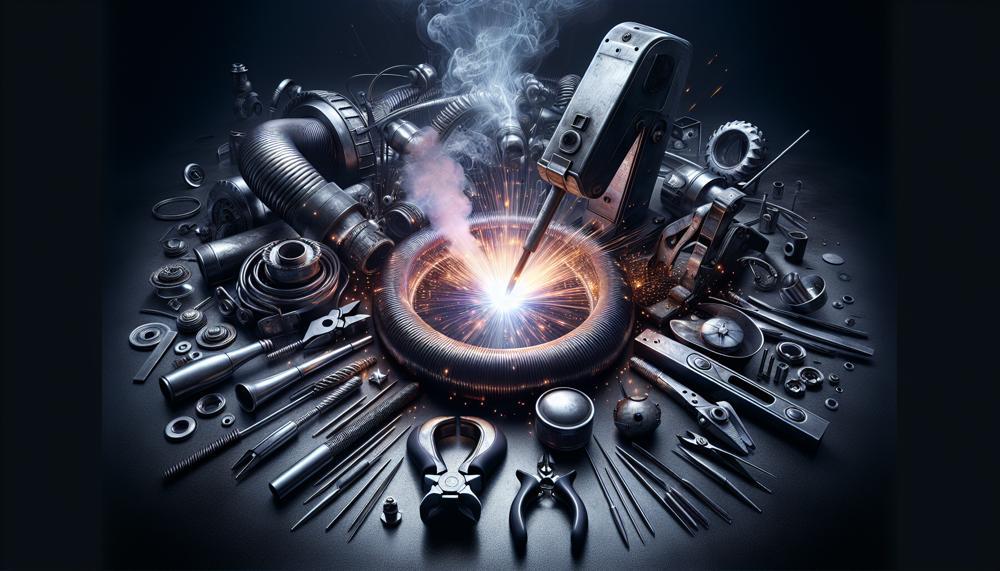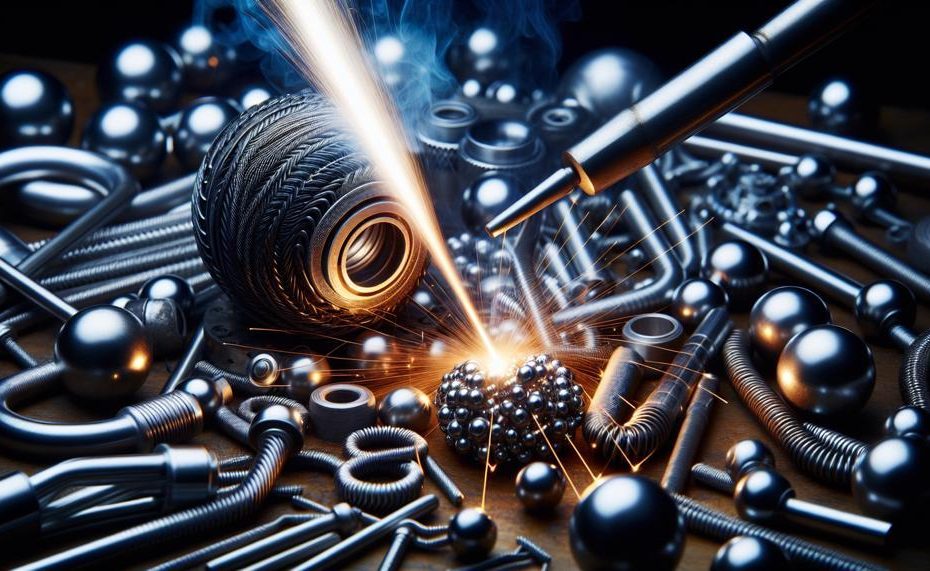Any skilled welder knows that the right tools and techniques can make all the difference in creating strong and precise welds.
Tungsten balling has become a popular and effective method for working with aluminum. Aluminum is a notoriously challenging metal.
In this post, we’ll take a deep dive into the world of tungsten balling. We’ll explore its purpose, process, benefits, and potential drawbacks.
We’ll walk you through each step of this specialized technique. This involves preparing the tungsten electrode and adjusting welding settings. Then, strike an arc and form a ball on the tip of the electrode. Finally, use it to weld aluminum with precision and control.
Whether you’re an experienced welder looking to expand your skills or a novice eager to learn more about this fascinating process, keep reading. We’ll uncover all there is to know about how to ball tungsten for aluminum welding.

Contents
- 1 How to Ball Tungsten for Aluminum Welding
- 2 Importance Of Correct Tungsten Electrode Tip Shapes
- 3 Factors Affecting Suitable Tip Shape For Aluminum Welding
- 4 Types Of Tungsten Electrodes For Welding All Metals
- 5 Choosing The Right Tungsten Tip Shape For Aluminum Welding
- 6 Impact Of Tungsten Tip Angles On Penetration And Bead Profile
- 7 Conclusion
How to Ball Tungsten for Aluminum Welding
Balling tungsten is a fundamental technique in welding aluminum, as it shapes the tungsten electrode into a smooth, rounded tip.
This process is essential in ensuring precise and visually appealing welds. Balling tungsten offers several benefits for the aluminum welding process:
Tungsten electrodes can be easily shaped and customized using a tungsten electrode fixture. This allows for greater flexibility and precision in creating the desired electrode shape and thickness.
| Enhanced Arc Strike | By balling the tungsten, the tip becomes smoother, allowing for better arc strike and stability. This results in a more consistent and controlled welding process. |
| Improved Aesthetics | Balling tungsten produces a brighter and more visually appealing weld pool, making it ideal for automotive applications where appearance matters. |
| Superior Heat Conductivity | Tungsten alloys specially designed for aluminum welding have excellent heat conductivity, eliminating concerns about incorrect temperatures during welding. |
| Increased Corrosion Resistance | By adding zirconium oxide or cerium oxide to tungsten electrodes, they become more resistant to rust, wear, and corrosion, making them an ideal choice for welding aluminum. |
Importance Of Correct Tungsten Electrode Tip Shapes
Tungsten electrodes come in different shapes, such as pointed, balled, and truncated cone.
Each shape has its own advantages and impacts on the welding process, especially when it comes to welding aluminum.
Types of Tungsten Electrode Tip Shapes:
- Pointed: This is the most widely used shape for tungsten electrodes. It produces a focused and condensed arc, making it perfect for precise and detailed welding. However, when it comes to aluminum welding, a pointed tip can lead to overheating and potential contamination of the tungsten.
- Balled: This shape is created by heating the electrode tip until it forms a ball. It is highly recommended for aluminum welding as it creates a stable arc and prevents tungsten contamination. The ball shape also allows for better heat dissipation, resulting in smoother welds.
- Truncated Cone: This shape is similar to a balled tip but has a flat end. It is a good compromise between a pointed and balled tip, providing both a focused arc and improved heat dissipation.
How Different Tip Shapes Affect Aluminum Welding:
- Arc Shape: A pointed tip creates a narrow and concentrated arc while a balled or truncated cone shape produces a wider and more stable arc that is better suited for aluminum welding.
- Heat Distribution: A ball or truncated cone shape allows for better heat dissipation, preventing the tungsten electrode from overheating and potential contamination.
- Tungsten Contamination: As mentioned earlier, pointed tips can result in tungsten contamination during aluminum welding, which can affect the quality and strength of the weld.
- Weld Appearance: The shape of the electrode tip can also impact the appearance of the weld. A balled or truncated cone shape results in smoother and more visually appealing welds compared to a pointed tip.
Factors Affecting Suitable Tip Shape For Aluminum Welding
The suitable tip shape for aluminum welding is greatly influenced by the shape of the tungsten tip. This factor significantly affects the welding process. It affects the arc shape, heat distribution, and tungsten contamination.
When shaping the tip, consider multiple factors. These include the type of materials being welded, the thickness of the joint, and the desired bead profile.
For aluminum welding, balled or hemispherical tips are commonly preferred. This is because they can maintain a stable and consistent arc. This shape also helps prevent tungsten contamination. Tungsten contamination can negatively affect the appearance and quality of the weld.
However, for thinner materials, a pointed tungsten with a small ball at the end can also be effective.
Another critical aspect to consider is the angle of the tungsten tip. Different angles offer varying levels of penetration and arc stability.
For optimal results in aluminum welding, a 30-degree angle is recommended.
Types Of Tungsten Electrodes For Welding All Metals
When it comes to welding all types of metals, there are four main types of tungsten electrodes that are commonly used: pure tungsten, thoriated tungsten, ceriated tungsten, and lanthanated tungsten.
Each type has its own unique properties that make them suitable for different welding applications and specific metals.
Pure tungsten electrodes are the ideal choice for precision welding on thin metals, while thoriated electrodes have the advantage of excellent current carrying capacity.
Ceriated electrodes strike a good balance between current capacity and arc stability, and lanthanated electrodes boast the highest current capacity and versatility.
In terms of performance, pure tungsten electrodes produce a stable arc but tend to form a ball at the end, which can affect overall weld quality.
On the other hand, thoriated electrodes have higher current carrying capacity. However, their use of radioactive materials poses potential health hazards.
Ceriated electrodes offer a good balance between current capacity and arc stability. They don’t have the added risk of using radioactive materials.
Lanthanated electrodes have the highest current capacity. They can be used for both AC and DC welding on a variety of metals.
Choosing The Right Tungsten Tip Shape For Aluminum Welding
When it comes to aluminum welding, you can choose from three main tungsten tip shapes: pointed, balled, and truncated cone. Each of these shapes has unique properties. These properties can significantly impact the welding process.
Pointed
Pointed tips are ideal for working with thin materials. Due to their focused and intense heat, they allow for precise welding. The smaller surface area of the pointed tip also helps prevent burn-through on delicate materials, making it a popular choice among welders.
Balled
On the other hand, balled tips are more suitable for thicker materials. They spread out the heat more evenly, resulting in a larger weld bead and deeper penetration. The spherical shape of the balled tip makes arc starting easier. It also improves stability during welding.
If you’re looking for a balance between the two aforementioned tip shapes, then truncated cone tips are your best bet. They have a larger surface area than pointed tips but still offer a focused heat similar to that of a pointed tip. This makes them versatile enough to work on both thin and thick materials.
The shape of your tungsten tip is crucial in the welding process as it affects the concentration of heat and stability of the arc. Therefore, it’s essential to select the right tip shape based on the thickness and type of aluminum being welded to achieve optimal results.
Impact Of Tungsten Tip Angles On Penetration And Bead Profile
The impact of tungsten tip angles on penetration and bead profile when welding aluminum is significant. Tungsten tips are commonly used at 30, 60, and 90 degrees for aluminum welding. Each angle has its own strengths and weaknesses, and the selection of the appropriate angle depends on the material thickness and desired result.
A 30-degree angle offers a narrow yet deep penetration, making it ideal for thinner aluminum materials. This produces a smaller weld pool and is beneficial for welding in confined spaces. However, it may not be suitable for thicker materials as it can result in insufficient penetration.
On the other hand, a 60-degree angle provides a wider but shallower penetration. This makes it suitable for thicker aluminum materials. The wider arc helps distribute more heat. This leads to better fusion between the base metals. However, this angle may cause excessive heat input and distortion in thinner materials.
For a balanced penetration, a 90-degree angle is the ideal choice, making it suitable for both thin and thick materials. This angle also results in a flat weld bead profile, which is desired for certain applications. However, it requires more skill from the welder to maintain the correct arc length and angle.
Conclusion
In conclusion, it is crucial to become proficient in balling tungsten for aluminum welding. This skill is essential for achieving strong and precise welds. This specialized technique requires a thorough understanding of its purpose, process, benefits, and potential drawbacks.
Welders can confidently take on the challenge of working with aluminum, a notoriously difficult metal to weld. They can achieve this by mastering these aspects.
We have covered all the necessary steps involved in this fascinating process. We covered preparing the tungsten electrode, adjusting welding settings, and forming a ball on the tip. But why bother with balling tungsten? It offers several advantages for aluminum welding. These include enhanced arc strike, improved aesthetics, superior heat conductivity, increased corrosion resistance, and flexible electrodes.
However, it’s crucial to select the correct tungsten electrode tip shape for optimal results. Pointed tips work best for thin materials while balled or truncated cone shapes are suitable for thicker materials.
When choosing a tungsten electrode for welding all types of metals, including aluminum and stainless steel, you must consider various factors. These include material type and thickness. For instance, pure tungsten electrodes are ideal for precision welding on thin materials. Meanwhile, thoriated or lanthanated electrodes offer high current capacity.
Additionally, welders must always follow safety protocols. They handle potentially hazardous, radioactive materials found in certain types of electrodes.





